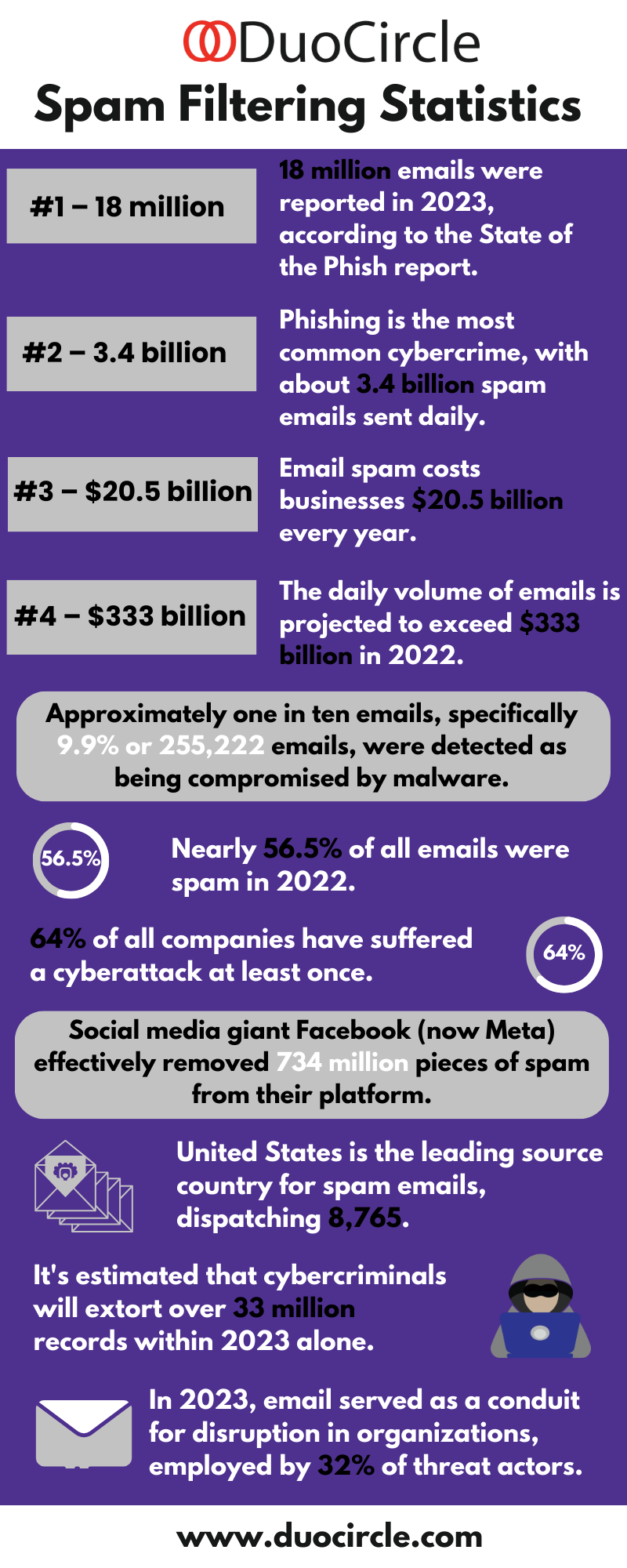Spam is referred to as “Unsolicited Commercial Email”. The spam filter is a type of program or software designed specifically to block unsolicited and indiscriminate content sent over the email. Constant nuisance created by an information system security threat named SPAM is not going anywhere for coming years. Spam mail titles are too catchy that one tends to read the mail and this infects the organization’s networks and information system.
For security reasons, there is an urge for an effective spam filter system. The spam filter is a reliable security control against adversaries. The job of a spam filter is to look for particular words in the email or website content based on precise filtering analysis and consequently excludes them from the user’s inbox. If we check the various published reports.
It was found that 50% of the email messages sent globally were listed as spam.
The spam filter is mandatory to safeguard the security of organizations that receive tons of content each day. Although, it is not possible to prevent tenacious spammers from junk mail completely, installing anti-spam solutions can significantly reduce the amount of spam.
How To Prevent Spam Emails?
Anti-spam solutions are of great help in one’s business if one is experiencing spam emails in huge volumes. Spam is a serious security threat as it affects every internet user directly or indirectly, and there is no real solution to spam in comparison to anti-virus software programs. Spam emails sent by unknown senders can be filtered out effectively with a proactive Anti-spam solution, which is a time-saving process.
There are a variety of spam filtering methods available today, and all the methods have only one goal, and that is to “REMOVE or STOP” unwanted emails. A few of the ways are listed below.
Spam Filtering By Content
This is the most commonly used technique to block spam emails. The most common spam words include additional income, cash prize, and you are a winner. Such catchy words or emails need to be filtered.
Blacklisting Certain IPs
Spammers mostly use the IP address for hacking. In such a scenario, organizations need to blacklist specific IP addresses. In this way, they can prevent spam emails from those IPs.
Real-Time Blackhole List
This real-time blackhole list is similar to a blacklist except that third-party enterprises maintain it. Whenever a mail comes, the filter connects it to the third party system each time to compare the sender’s address against the preset list. This outsourcing is productive in organizations where the IT staff doesn’t have enough time to spend manually on maintaining blacklists.
Heuristic Filters
Heuristic filters are a form of content-based filters that focus on suspicious words that are commonly found in spam messages. Frequently received suspicious words such as ‘Rolex or ‘Viagra etc. are marked high scores while the terms found in regular emails receive lower scores. As determined by the anti-spam application’s administrator, the filter blocks the messages containing high-scored words.
Bayesian Filters
Bayesian Filters are considered as an advanced and recent form of content-filtering methods. These filters take into practice a mathematical probability to classify the different recurring words in two separate lists, i.e., junk and legitimate. A time span is required by Bayesian filters to continually maintain this list after analyzing the content of received emails by users. Thus, their effectiveness is seen as long as you use them. In the first instance, you may have to delete the junk files on your own.
DNS Anti-Spam Method
DNS lookup system looks for the Domain name of the sender that they use to identify themselves. The system tries to verify the email address with that of a valid MX record. If there is no match, then the message is assumed to be junk and removed automatically by the system. This lookup will accurately reveal the domain name associated with the server and is proved to be useful in detecting spam.
OOP Spam Filter API
In case, you are also searching for an email spam filter, then take a note of the below-given spam filter API version. It may help you to cope up with your needs. This spam filter is manufactured to filter any content exchange, whether it’s a blog, forum, or social media. The use of various tools is combined in such a way that it helps to detect the number of spam words in content in an efficient manner and not to leave any drawback. It supports the following features:
Machine Learning Algorithm
A well-trained and inbuilt machine learning algorithm detect whether the content is spam or not.
Scoring Spam
It follows an advanced heuristic spam filtering method. A score ranging from 0 to 6 is assigned to every content, and one has a higher probability considered as spam.
Spam Word Detection
The content containing a large number of words are detected against a list of common suspicious spam words. This list may be preset or continuously maintained by the filter depending upon the mathematical probability of received messages.
Blacklist IPs List
The screen is capable of maintaining a constant list of spammers Ips and are updated in their servers and categorized as blacklisted IP list and throw out the spam messages.
Language Outlier Detection Algorithm
This particular technique of the filter enables the analysis of language received in content and ensures that it integrates well with your expectations. It is deployed on Rapid API where you can easily find detailed information about the application.
Conclusion
Is it realistic to avoid using spam filters? Hopefully, the answer is prevalent in the article above. It highlights the significance of using spam filters as a reliable control measure. Not only phishing attacks, but spam can also exploit the information systems, causing the loss of sensitive information. The Spam filters will also help prevent the phishing attacks attempted by adversaries.


